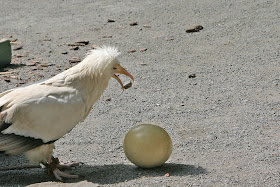Welcome
new and returning readers! Today’s
blog is about Osiris—not the Egyptian God of the Dead—but an amazing Egyptian
Vulture that resides at the World Bird Sanctuary.
Meet Osiris, the only Egyptian Vulture ever hatched at WBS
First
off, there are two groups of vultures; Old World and New World. There are 15 Old World vultures and 7
New World vultures, with 22 in total.
The big difference between old and new is old world vultures are related
to birds of prey, and have very strong feet. New world vultures are more closely related to storks and
cranes, and have no strength in their feet. Egyptian vultures are Old World
vultures and are native to northern Africa, southern Europe, the Middle East
and India. In those areas they can
be seen in the mountains, wetlands, plains, and uplands.
How could anyone resist Osiris's new age hairdo?
Egyptian
Vultures are very adaptable birds whose territories will even include populated
areas. Sometimes they can be
spotted at garbage dumps. These
beautiful vultures will eat carrion (dead animals), eggs, and they will even
catch and eat large insects.
Osiris demonstrates the Egyptian Vultures' tool using ability
Eating
the eggs of other birds is a very well known trait of the Egyptian
Vulture--especially how they do it.
Egyptian Vultures are among the few birds that
use tools! They will use stones
and with their beaks throw them on the eggs to
break them. Once the eggs are
broken, they will then use their long slender beaks to pry off the fractured
shell pieces to get to the very nutritious center! In addition to flying in our shows Osiris demonstrates this
remarkable tool using adaptation for our audiences!
Egyptian
Vultures live up to 20 years in the wild.
In captivity however, they can live much longer. The longest recorded age in captivity
was 37 years old. At 14 years of
age, Osiris has a long way to go.
Osiris
was hatched in the spring of 1998 at the World Bird Sanctuary. She was the only Egyptian Vulture to be
bred here.
In
the wild, these vultures like to nest on mountainous cliffs and ledges that
have cavities where they can nest under an overhanging rock to provide chicks
with shade and little direct sunlight.
Their clutch size ranges from one to three eggs. During incubation, if an egg is stolen
or damaged early in the incubation period, they can lay another to replace
it. The chicks will fledge (leave
the nest) at the age of only three months! The fledglings’ plumage (feather color) will change from
brown to white over a period of months.
Mature Egyptian Vultures have white plumage with head feathers that give
them a touseled look. I especially
love Osiris’s head feathers!
These
vultures are among the group of animals on the Endangered Species List. There are a variety of different
reasons why they are at risk. Lead
poisoning from gunshots, electrocution from power lines, collisions from wind
turbines, direct and indirect poisoning, and habitat change.
Adopt A Bird parents will have a private visit with Osiris
Osiris
is available for adoption in our Adopt a Bird program. To find out more information, call
636-861-3225. All adoption
donations are tax deductible.
Osiris is a very smart and beautiful bird. I actually adopted her in 2010 as a birthday gift for
someone. Adopt A Bird Parents will
need to make a reservation to see her since she resides at the behind the
scenes ETC (Educational Training Center) building. The ETC is not normally open
for public viewing except during our Open House in October each year.
Submitted
by Lisbeth Hodges, World Bird Sanctuary Naturalist





No comments:
Post a Comment